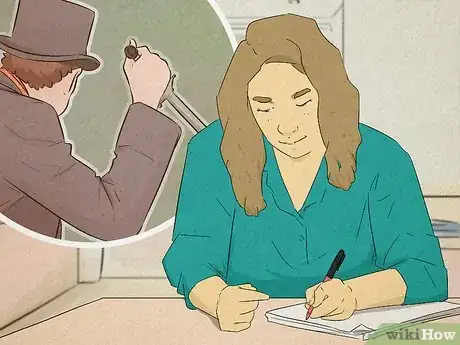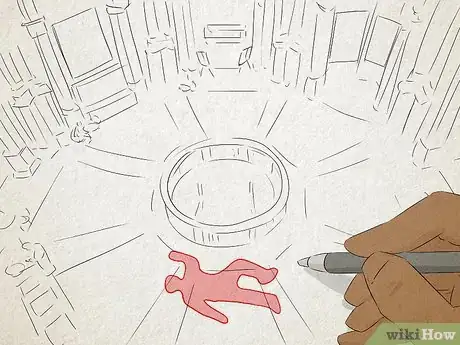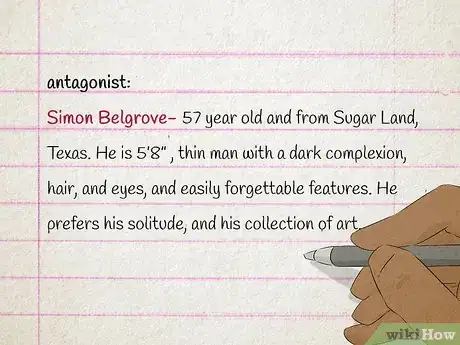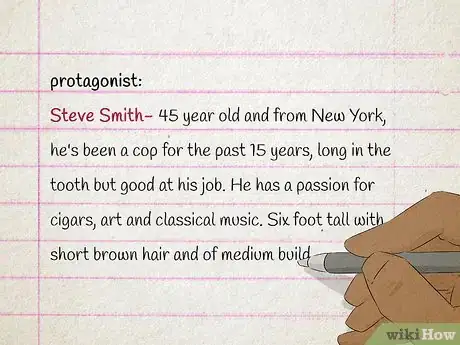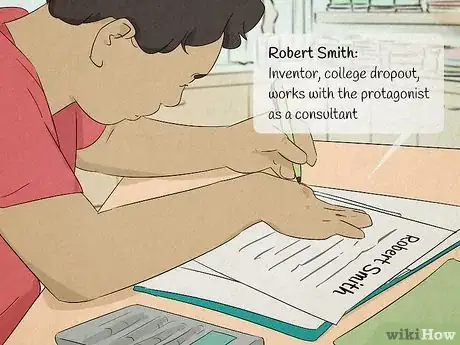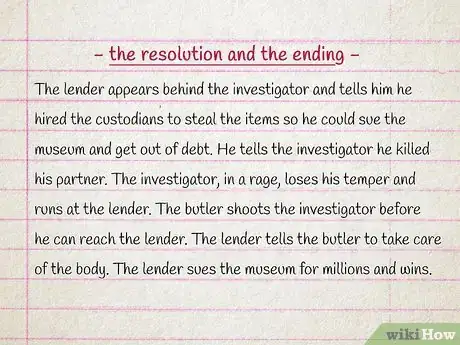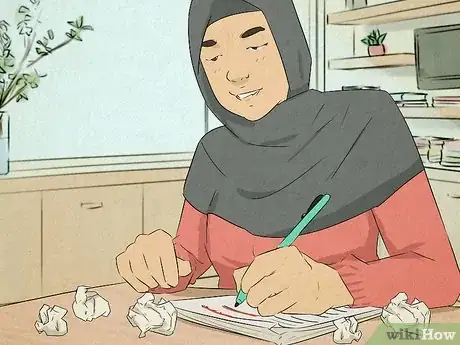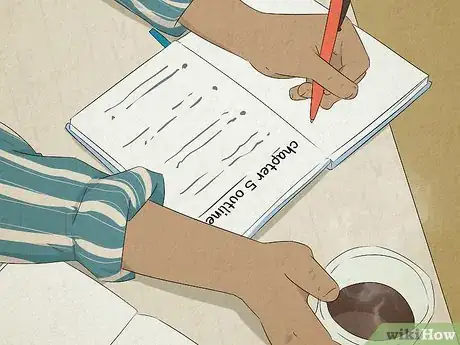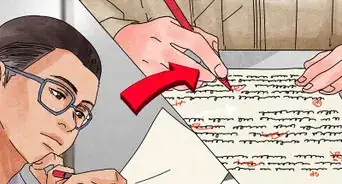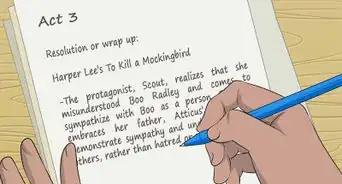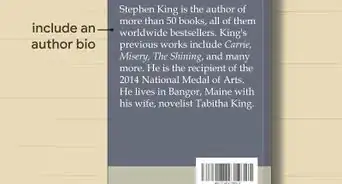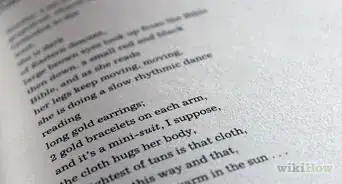This article was co-authored by Lucy V. Hay. Lucy V. Hay is a Professional Writer based in London, England. With over 20 years of industry experience, Lucy is an author, script editor, and award-winning blogger who helps other writers through writing workshops, courses, and her blog Bang2Write. Lucy is the producer of two British thrillers, and Bang2Write has appeared in the Top 100 round-ups for Writer’s Digest & The Write Life and is a UK Blog Awards Finalist and Feedspot’s #1 Screenwriting blog in the UK. She received a B.A. in Scriptwriting for Film & Television from Bournemouth University.
This article has been viewed 36,074 times.
Beginning a novel can be tough. Many writers find it useful to use an outline to organize their novel. An outline is a general idea of where your novel will go, and it is a way to organize your ideas ahead of time. Outlines are especially important with mystery novels. Mystery novels focus heavily on plot, including twists and turns. The main part of a mystery novel is the suspense throughout as the reader tries to figure out whodunit. Therefore, you need to have a clearly laid-out plan ahead of time, as you need to know who committed the crime and how to create surprise along the way.
Steps
Developing the Novel’s Characters and Plot
-
1Decide on the crime you wish to portray. Murders are the most common, but what type of murder? You can read crime blogs or the local newspaper to get ideas—life is often stranger than fiction. You could also write about political intrigue or spy fiction.
- For this article, the example will focus on a murder mystery novel.
-
2Write down all the details of the crime and usual visual aids if needed. Details are extremely important in mysteries. Where did it happen? What was the weapon? What was the time frame? What kind of evidence got left behind? Create a list of what happened, but also draw things out if you need to. How is the scene laid out?[1]
- Draw a map of the room or space.
- Draw a diagram of the weapon if it helps. Add colors.
Advertisement -
3Decide who the murderer is. Give the person a name. Put that name at the top of a sheet of paper. Begin to fill in details for the character.
- Start with physical characteristics and basic facts. How tall is this person? What’s her height? What type of hair does he have? Where was she born? Are his parents still alive? Does she have any siblings?
- Next, go for personality traits. Who is this person? What are her favorite past times? What does he eat for breakfast? What kind of pet does she have? What’s his favorite color? What are her personality quirks? What makes him afraid in the middle of the night? What drives her to do what she does? Is the crime an accident or intentional?
- Even though this person is a murderer, you don’t want him or her to be one-dimensional. He or she still needs to be a fully developed character, and it’s the little things that make a person seem real.
-
4Create a protagonist. Once you've created the murderer’s character, create a sheet with the protagonist’s (or hero’s) name on top of it. Ask yourself the same questions that you did when creating the murderer’s character.[2]
- Decide what makes him or her tick. Why does she want to catch the murderer? Is it personal or just another day on the job?
-
5Develop the secondary characters. Don’t forget to include other characters who could potentially be the murderer. That’s part of the suspense of the story—nobody is sure exactly who committed the crime (except for you). So you will need equally as compelling characters who didn’t commit the murder but who plausibly could have.
- Don’t forget to include diversity in your characters. Real life is diverse, and your characters should be, too.
-
6Create a story arc for your protagonist or villain. Basically, the arc is his or her personal story throughout the novel. How is she or he going to change in the novel? How is he or she going to change other people? What is going to happen to him or her?
- Decide what perspective you will use. Are you going to tell it from the protagonist’s perspective or the villain? Are you going to mix the two? Will you use an omnipresent third voice?
Outlining the Story
-
1Begin by writing some information down about the set-up. Think about the setting as well.
- What leads into the crime?
- What makes the murder personal to the protagonist?
- Will the story follow both the protagonist and the villain or just one or the other?
- Where will it all take place?
- How does that affect the crime?
- Why did you choose that setting in particular?
-
2Transition from set-up to crime. How does the protagonist get involved? Is she a cop, or does she become involved in some other way? What pieces of evidence does the protagonist find at the scene? What is she able to put together at this point?
- Your protagonist doesn't have to be right about what she “knows”; that could easily change throughout the storyline.
-
3Keep the story moving. What are the major events in the middle? Maybe the protagonist follows up on a lead only to find it was a dead end. Maybe he has things going on in his personal life that dive bomb into the crime story, such as his family is threatened or he finds out his child is somehow involved in the story.
- Decide what the antagonist is doing throughout the middle. Is she running? Hiding out? Trying to find details to prove her innocence? Does he narrowly escape being caught? Is she taunting the protagonist by sending tantalizing clues or notes or by making phone calls?
-
4Drop clues throughout the story to lead your reader on. However, make sure not to make it too obvious. The reader should have pieces of evidence just like the protagonist.[3]
-
5Decide on a climax. Throughout the story, you are building up suspense. The suspense resolves in a climax, or the high point of the story. In the case of mystery, the climax is usually the villain getting caught. However, how that happens is up to you.
- Usually during the climax there is some doubt as to whether the protagonist will succeed, which creates suspense.
-
6Move on to the resolution and ending. What happens to each of the characters at the end? Though you don’t have to tie it up with a nice bow, your readers will want to know at least a little bit about what happens to each character.[4]
Staying Organized as You Write
-
1Be open to changes. As you write, your story is going to change. You’re going to come up with new ideas and details. As you go along, take notes on what you change.
- If you decide on something about a character, add it to his or her character page(s).
- If you change something in the plot, make a note of it, and change any subsequent storylines to reflect it.
-
2Keep track of the important details. If things get complicated, create charts of how things are related. For instance, you can create family trees for characters to show how they are related, both by family ties and by events in the book.
- You can also create charts for things like pieces of evidence to show what they are and how they relate to the rest of the book.
-
3Consider writing an outline for each individual chapter. An effective way to organize a novel is to begin with an outline, both of your characters and the plot. If it helps, you can go chapter by chapter creating an outline of what happens in each one. Some writers find that helpful, while others find that just creating a general outline is fine. Do what works best for you, and continue to keep track of details as you write.[5]
Expert Q&A
-
QuestionWhat makes a good mystery novel?
 Lucy V. HayLucy V. Hay is an author, script editor and blogger who helps other writers through writing workshops, courses, and her blog Bang2Write. Lucy is the producer of two British thrillers and her debut crime novel, The Other Twin, is currently being adapted for the screen by Free@Last TV, makers of the Emmy-nominated Agatha Raisin.
Lucy V. HayLucy V. Hay is an author, script editor and blogger who helps other writers through writing workshops, courses, and her blog Bang2Write. Lucy is the producer of two British thrillers and her debut crime novel, The Other Twin, is currently being adapted for the screen by Free@Last TV, makers of the Emmy-nominated Agatha Raisin.
Professional Writer Mystery novels usually begin with a crime or question that the main character needs to answer. This is what drives the plot.
Mystery novels usually begin with a crime or question that the main character needs to answer. This is what drives the plot. -
QuestionIs it okay to discover the story along the way instead of planning?
 Froggy Hop//SophieCommunity AnswerIt's not recommended. You should have at least a basic idea for every character and chapter or there might be inconsistencies or clues left out while writing. If you want to change a detail while you write, you might miss a spot and cause confusion. So it's best to have a plan, even if it's not much of one. However, some writers can write this way, it's a very individual thing.
Froggy Hop//SophieCommunity AnswerIt's not recommended. You should have at least a basic idea for every character and chapter or there might be inconsistencies or clues left out while writing. If you want to change a detail while you write, you might miss a spot and cause confusion. So it's best to have a plan, even if it's not much of one. However, some writers can write this way, it's a very individual thing.
References
- ↑ https://www.creative-writing-now.com/how-to-write-a-mystery.html
- ↑ https://www.how-to-write-a-book-now.com/mystery-novel-planning.html
- ↑ https://www.creative-writing-now.com/how-to-write-a-mystery.html
- ↑ https://nybookeditors.com/2016/12/write-convincing-mystery/
- ↑ https://www.writersdigest.com/writing-articles/by-writing-goal/write-first-chapter-get-started/how-to-organize-and-develop-ideas-for-your-novel
